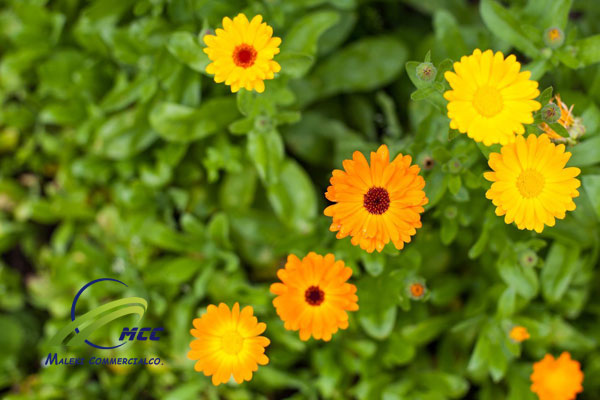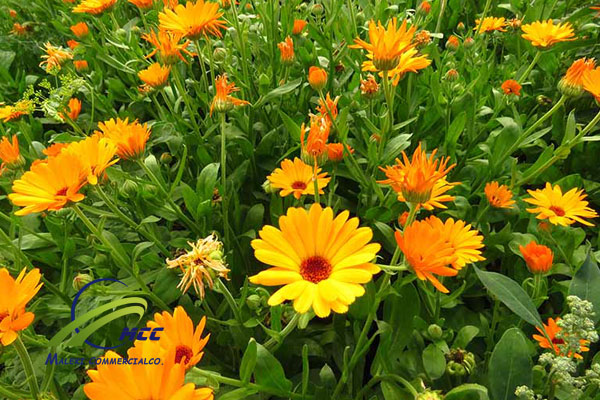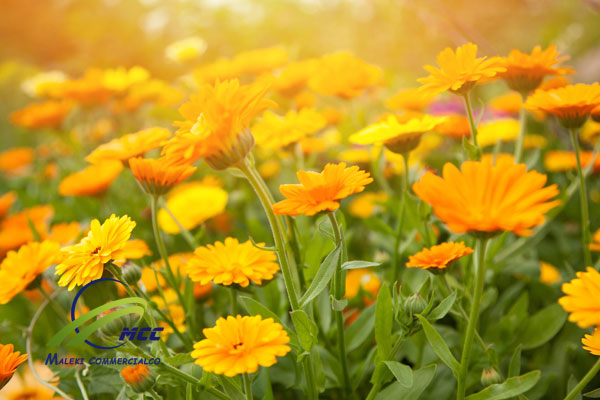All about growing marigolds
What is a marigold?
Marigold(Calendula officinalis L.) is a member of the Asteraceae family. It is one of the most commonly used herbs in the pharmaceutical industry that is also a popular medicinal plant in the international markets.
Botanical characteristics
Marigold is a herbaceous plant, annual or perennial. The leaves are lanceolate, narrowly ovate, oblong or spoon-shaped, pointed or slowly-pointed, and contain tuberous to the hairy spider- thin peach-colored hairs. In addition, the margins of the leaves are usually almost complete or serrated and appear indistinct wavy. The roots of the marigold are cone-shaped. The stem of this plant reaches a height of 40 to 70 cm. The flowers are lingual forms, often 2 cm long and yellow or orange in color. The tubular flowers are also almost the same color as the lingual flowers and are sometimes brown. The achene fruit is brown and weighs 8 to 12 gr.
Chemical compounds
Marigold contains numerous chemical compounds such as cesium terpene glycosides, water-soluble polysaccharides, flavonoids, carotenoids, essential oil, salicylic acid, organic acids, resin, albumin, Saponins, stigmasterol , cytosterol, alpha-cadinol, faradol and arnidol.
Pharmaceutical parts
Aerial organs
Geographical distribution
Global distribution
This plant can be grown all over the world.
Distribution in Iran
Hamedan, Ardabil,Karaj,…
Ecology of cultivation
- To grow well, marigold needs sunlight.
- The surface of the field must be leveled for cultivation.
- This species grows best in soils with a pH between 4.5 and 8.2.
- Moisture in the soil promotes the growth of fungal diseases, so this plant should not have too much moisture.
- This plant tolerates cold temperatures down to 0 oC.
- The plant should be irrigated regularly to maximize the quality of the active ingredients.
- For effective growth, the soil should allow good aeration.
- The seeds germinate at 8 to 10° C after 7 to 14 days.
- For cultivation, the average temperature is 17 to 18 oC in June and 19 to 20 oC in July.
Alternate Cultivation
It is possible to cultivate another plant after harvesting this one. Marigolds should not be planted in the same field less than two years apart.
Preparation of the soil
- After plowing, a suitable chemical and plant fertilizer should be added to the soil.
- After the addition of chemical fertilizers, the soil should be leveled with a leveling disk, as a good leveling of the soil will ensure that there are no mounds and that there is no waterlogging.
Cultivation Time
The best time to grow this plant is in the second half of March.
Harvest time
Depending on the climate of the growing area, this plant can be harvested between the end of June and mid-November.
Growing method
- These plants are planted with seeds that are sown in rows with a spacing of 40 to 50 cm.
- During the growing period of this plant species, the field should be weeded 1 to 2 times.
- Seeds should be grown at a depth of 2 to 3 cm.
- Per hectare, 6 to 8 kg of seed with high vigor is required.
- Seeds should be irrigated immediately after sowing.
Fertilizers required
- Phosphorus oxide
- Potash oxide
- Nitrogen
Pests and diseases
- Leaf spot fungus (Entylmoa calendulae)
- Mildew (Sphaerotheca fuliginea)
- Leaf-eating caterpillars
- Mold or rust
Collection Method
- Flowers and sepals are harvested together, then sepals and flowers are separated and dried.
- It is possible to dry flowers and sepals together if desired.
- There are two traditional ways of drying, in the shade or with a dryer.
- Each hectare yields 350 to 450 kg of dried flowers.
- Each hectare yields between one and two tons of dried flowers with sepals.
Maintenance method
Plants should be stored in cotton bags away from sunlight and moisture.
Medicinal properties
- Anti-toxin
- Anti-fever
- Against flatulence
- Antifungal
- Analgesic
- Anti-parasites
- Anti-inflammatory
- Anti-vomiting
- Anti-viral
- Antibacterial
- Anti-inflammatory
- Anti-tumor
- Period triggered
- Diuretic
- Treatment of hemorrhoids
- Treatment of constipation
- Treatment of burns
- Treatment of flu
- Treatment of insect bites
- Healing of wounds
- Treatment of skin inflammations
- Treatment of inflammation of the throat and mouth.
- Strengthens the heart
- Relieves muscle cramps
- Stimulates the immune system
- Lowers blood pressure
- Prevents hemorrhoids
Contraindications
People prone to allergies should avoid using this plant.
Precautions
- Pregnant women
- Breastfeeding women
Side effects
- Inflammation of the skin on contact
- Anaphylactic shock
Note: Please ask your doctor before taking marigold to treat the disease.
Maleki Commercial, the largest exporter of Marigold
Maleki Commercial is the largest direct exporter of Marigold in Iran and Asia. This company
exports the best quality of this plant as per the buyer’s requirement in the form of EXW, FCA, CPT, CIP, DAT, DAP, FOB, FAC, CFR, CIF.
Our consultants can assist you with bulk purchases.
Supplier of Marigold in Iran
According to buyer’s requirement, Maleki Commercial exports the best quality of Marigold in the form of EXW, FCA, CPT, CIP, DAT, DAP, FOB, FAC, CFR, CIF.

Global export of Marigold
Maleki commercial is one of the leading global exporters of Marigold that have the most effective ingredients and best quality and price among other companies that export this plant. This holding has been very successful in exporting this plant to different countries without
intermediaries.
You can rely on this company to provide the best quality products in safe and standardized packaging when you need this kind of high-quality export.
Marigold price in Iran
Maleki Commercial exports Marigold at the best price and quality under the brand Elisso Sky to the United States, Europe, and Asia and has already attracted numerous customers.

